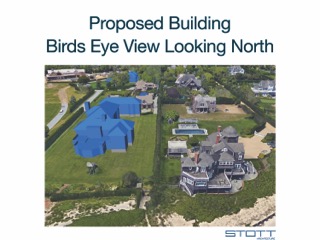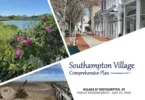From 27East/Press News Group 10/25/17 By Greg Wehner
the sizable new compound at 28 Gin Lane, with a 5,055-square-foot guesthouse on the attached property at 24 Gin Lane. Board members Jeff Brodlieb and Susan Stevenson opposed the plans.
According to the written decision, the board determined that, after nine months of changes and modifications—the application originally proposed a 17,670-square-foot home on 3.7 acres of an irregular but buildable flag lot, but the size of the house was reduced by nearly 17 percent, down to 14,561 square feet—the owner could move forward.
“The resultant dwellings comply with the standards of the historic code, the owners responded to concerns of the neighbors, and the dwellings are compatible as new construction with the neighborhood of the historic district in which it is located,” the decision read.
Mr. Brodlieb said on Wednesday morning that he voted “no” because of the size and massing of the structure—particularly a more than 200-foot-long facade, which faces Lake Agawam—echoing concerns voiced by some neighbors.
“To provide you some perspective of the mass of this structure, a NYC block is approximately 260 feet long with 230 feet of building facade,” Mr. Brodlieb said in an email. He added that a structure of this size is “visually incompatible with surrounding properties and the neighborhood.”
He also said he was concerned that matters of material concern were left open on August 28, when the hearing was closed, and not resolved.
As board members initially were set to vote on the written decision on Monday, Mr. Brady said he had only just received the draft of the proposed action at the beginning of the meeting and was not ready to vote. Briefly, the board considered adjourning the vote until its next meeting, on November 13.
But Southampton Village-based attorney John Bennett, who was at Monday’s meeting to represent the property’s owner, international investor Scott Shleifer, said 30 days had passed since the review ended, and a decision was required that night.
Ultimately, the board went into recess for about 10 minutes, giving Mr. Brady time to read through the document.
After the recess, Amityville-based attorney Richard Handler, who spoke on behalf of families opposing the project, requested that the board delay the decision, arguing that Mr. Brady did not have enough time to review the drafted decision before voting, but Mr. Bennett objected, and board moved on to vote.
“I think the written decision is very well done,” Mr. Brady said before voting to approve the application. “I think it encompasses the full chart of events for the whole process.”
Hearings for both applications began on December 12, 2016, and stretched on for nine months, eventually ending on August 8, 2017.
During those hearings, representatives for Mr. Shleifer, neighbors and other objectors presented their testimony on why the application should or should not have been approved, and many of the objections focused on the main home, not the guest house.
Zachary Studenroth, the board’s architectural consultant, presented board members with a report of his findings in August, saying the home was “appropriate” for the estate section neighborhood.
“The proposed designs for two new, two-story dwellings on adjacent parcels on Gin Lane are appropriate within the architectural and historical context of the Southampton Village Historic District,” Mr. Studenroth said in his letter dated August 11. “Not only are each of the designs in compliance with applicable code requirements, but each responds architecturally to the challenges imposed by their long flag lots, which limit the effective buildable footprints within each parcel.”
Mr. Studenroth said the home features a gabled roof oriented east to west, and an elongated service wing that stretches to the north along the western property line and is connected by a loggia to the garage wing. A forecourt occupies the space between the main portion of the home and the garage.
He also said the massing and details of the main house minimize the visual impact of its size. It also has a hipped roof profile, perpendicular gables and roof elements that reach to the ground floor.
The guesthouse is situated on 2.75 acres and mirrors design elements of the main home.
Many neighbors, like Pam Michaelcheck, spoke out against of the project because of its mass and size, and in response the architect whittled away at the design. But in the end, it was not enough for the neighbors.
Mr. Brodlieb said the Village Board should take action to prevent such projects from going through in the future.
“The fact that such an extensively large building can be built on that lot, in that visually significant location, is a clarion call for the trustees to act quickly on the recommendations of the Planning Commission and to enact new zoning laws and redraft the codes authorizing the ARB to make them more effective and defensible,” he said.
After the board voted to approve the decision, Mr. Handler maintained that the ARB’s decision was not the final word on the proposal, and that he will take his fight to the Building Department, which still has to issue the final approvals.






